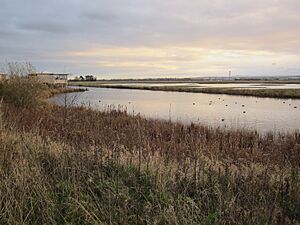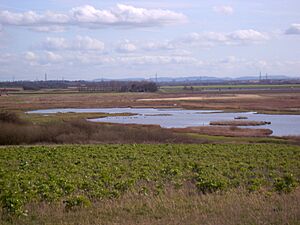Burton Mere Wetlands facts for kids
Burton Mere Wetlands is a special nature reserve located where Cheshire, England, meets Flintshire, Wales. It's found along the Dee Estuary. The Royal Society for the Protection of Birds (RSPB) looks after this amazing place. It even includes an older reserve called Inner Marsh Farm.
The reserve is close to the village of Burton. It's about 3 kilometers south of Neston. The RSPB has worked hard to create different types of wetland habitats here. You can also find beautiful bluebell woodlands and farm fields. All these areas are managed to attract lots of different wildlife.
You can visit the reserve from 9 AM until 9 PM (or until it gets dark). The main reception hide is open from 9:30 AM to 5 PM. If you are not an RSPB member, there is a small fee to enter.
Contents
The Story of Burton Mere Wetlands
This land used to be muddy tidal flats until the late 1800s. It was created when land was "reclaimed" during the building of the Wrexham to Bidston railway line. This means new land was made from the sea. After that, people used the land for grazing animals and for farming.
The RSPB bought land for the first part of the reserve, called Inner Marsh Farm, in 1986. This original reserve opened in June 1992. They built three shallow, freshwater pools. A footpath was also made, leading to a hide where people could watch the birds.
The reserve grew bigger when the RSPB bought more land in 2006 and 2008. These new areas were called Burton Marsh Farm and Burton Mere Fisheries. More wetland areas were created. New visitor facilities were also added. These included a reception hide, toilets, and a new entrance with a car park.
The whole reserve was officially renamed Burton Mere Wetlands in September 2011. The new section was opened by the famous TV presenter and naturalist Iolo Williams. Even more paths and viewing screens were added in April 2014. These new paths connected the old and new parts of the reserve.
Amazing Wildlife at Burton Mere Wetlands
Burton Mere Wetlands is a fantastic place for many different animals.
Birds of the Wetlands
Many kinds of birds visit the reserve. During winter and migration seasons, you can see lots of "waders." These are birds that feed in shallow water. Some examples include black-tailed godwits, spotted redshanks, and ruffs.
Winter also brings many types of ducks. You might spot pintails, shovellers, teal, and wigeon. Small numbers of Bewick's swans and whooper swans also visit.
You can also see many birds of prey flying over the marsh. These powerful hunters include short-eared owls, hen harriers, marsh harriers, merlins, kestrels, and peregrine falcons.
Breeding Birds
Many birds choose Burton Mere Wetlands to build their nests and raise their young. Good numbers of lapwings and redshanks breed here. These waders are becoming rarer in other parts of the country. Avocets also breed on the new pools.
Other breeding birds include yellow wagtails, skylarks, and various warblers. A large group of little egrets and grey herons nests in a nearby wood. In recent years, Western cattle egrets have bred here. There have also been attempts by great egrets and Eurasian spoonbills to nest. In summer 2019, ten pairs of Mediterranean gulls nested on the reserve.
Mammals and Insects
The reserve is home to several interesting mammals. You might see tiny harvest mouses or water voles. European hares also live here. Daubenton's bats fly over the wetlands at night, catching insects.
For insects, look out for the beautiful wall brown butterfly. The bright red-eyed damselfly can also be seen near the water.
Plants of the Wetlands
The pools at the reserve are surrounded by many different plants. You'll find tall reedmace, sea club-rush, and various types of rushes. Areas of damp grassland have plants like marsh foxtail and floating sweet-grass.
Wild flowers add color to the reserve. These include bright yellow marsh marigolds and fleabane. You can also find many wild orchids, such as the southern marsh orchid. The amazing bee orchid, which looks like a bee, is also present here.



